Wed 30 Apr 2008
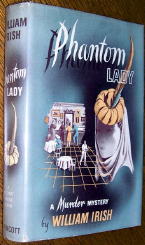
PHANTOM LADY. Universal; 1944. Ella Raines, Franchot Tone, Alan Curtis, Elisha Cook Jr., Thomas Gomez, Fay Helm. Based on the novel by William Irish, aka Cornell Woolrich. Director: Robert Sidomak.
You don’t go to pulp or paperback conventions to see movies, or at least I don’t, but I did this time. The recent Windy City show was great fun – well put on, with lots of people to talk to and hang around with for a few days – and one of the late night attractions was a showing of Phantom Lady, the pulp connection being rather obvious, since Woolrich’s writing career began in the pulp magazines.
First published by Lippincott in 1942, it’s the second novel that Woolrich wrote that I remember reading, the first being Deadline at Dawn (Lippincott, 1944) also as by William Irish, and also made into a movie (RKO, 1946), one that I consider as being my favorite of all time.
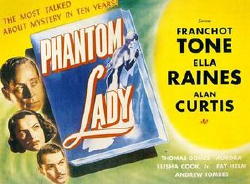
What’s strange, and I haven’t been able to explain it yet, is that I thought I remembered Phantom Lady as a movie, but if I saw it, and I’m sure I did, I didn’t remember it all that well.
It was shown at the Windy City show in a two reel format, and while all was well during the first reel – everything came back to me, pretty much as I expected – but when the second reel began, I discovered that I didn’t remember any of it at all. A severe case of déjà vue in reverse, you might say. The second reel began, if I recall correctly, as Carol Richman (Ella Raines), trying to break the testimony of the witnesses who claim they never saw the woman who is her boss’s alibi, begins the long sequence in which she tries to vamp jazz drummer Cliff Milburn (Elisha Cook Jr.) into telling the truth.
I’ve found some photos to go with this, as these are the scenes that everyone talks about when the movie comes up for discussion, and I’ll include some of them here. Not only that, but I’ve found the entire sequence on YouTube. Here’s the link. (I’ve never been able to insert videos into this blog, but maybe it’s time to try again.)

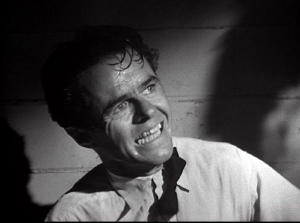
I’m of two minds about this portion of the movie, and the larger part of me wants to tell you that I think it’s silly and overdone. (I assume that you’ve gone to see for yourself and have made up your own mind.) And that may be the reason I don’t remember ever seeing it before last Friday night. Or maybe I never saw the movie before at all, and I just thought I had. It is an eerie feeling, and I can’t explain it.
You probably know the story, and let me sort of start over and get back to that. A man, Scott Henderson (Alan Curtis), who (as it turns out) has had an argument with his wife, shows up at a bar and offers to take a sad-looking lady her meets there to a Broadway musical. He has two tickets, but no one to go with. She accepts, but only on a “no names” basis.
He drops her off after the show, goes home, and finds three cops waiting for him, with his wife dead in the bedroom. His alibi? The phantom lady, the one with the hat, the lady that no one remembers ever seeing. One of the only ones who believes him is his secretary-assistant, Carol “Kansas” Richmond.
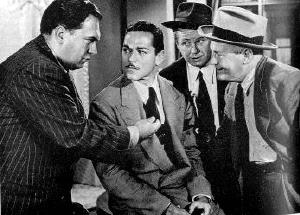
Pure nightmare, and pure noir. If I remember correctly, the first reel ended with Carol stalking the bartender through the darkened Manhattan streets, beginning with her first giving him the long silent treatment at the far end of the bar, then up to a elevated train station, and down again to a street farther downtown where she finally confronts him. It is, of course, the skilled black-and-white photography that makes this work, portraying a world of dark shadows and the feeling of helplessness in fine fashion.
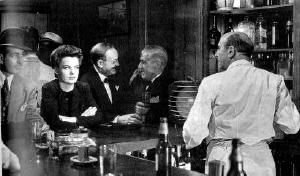
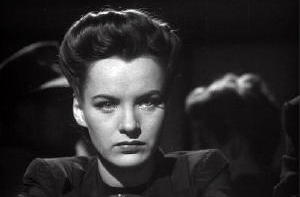
What doesn’t work in this movie, to my mind, are the gaping holes in the plot – there are so many I couldn’t begin to list them all, and I probably shouldn’t anyway – and the fact that the true killer is revealed too soon. I’m not sure if this is true in the book or not, as once again I have not read it in well over 50 years, but a lot of the puzzle is immediately swept away in the movie version. The only question left is how is he to be caught, and of course, he is. (I don’t believe I am giving anything away here.)
In the credits, Franchot Tone’s name is listed first, but since he doesn’t show up until the movie’s well over half over, I’ve switched his name above with Ella Raines, a dark brooding brunette (in this movie, at least). This was only her third film, and she’s the star attraction, all the way. For whatever reason, roles in future flicks seemed to come few and far between, a waste of good talent, as far as I can see.
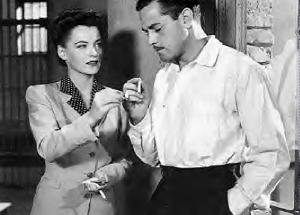
Alan Curtis is fine enough as the accused killer, an engineer with designs of helping mankind, but in all truthfulness, he seems far too resigned to his fate, nor does he realize how much his secretary is secretly in love with him. A true cipher, but the scenes in the jail between the two of them are beautifully done.
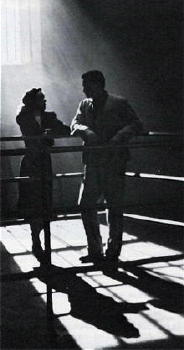
Bosley Crowther’s review in the New York Times seems to sum up all of the negative things I also might tell you about myself. He deserves credit for pointing the atmospheric effects, but how was he to know that later on this would be considered by many to be one of the gems of early film noir?
It is, but I have to warn you, I think he’s still largely right. This movie is a diamond in the rough, one designed for a small (or even large) sense of suspended disbelief. I still think Deadline at Dawn is the better film, but after the showing in Windy City, I seemed to be alone in that belief. I’ll have to watch it again, but do you know what? I’m almost afraid to.
FOOTNOTE: The phantom lady’s name is Miss Terry. How appropriate is that?
May 1st, 2008 at 6:41 pm
Hi Steve,
Well, another GREAT review as usual,(You’ve got to find a way to get paid for some of these!) although I don’t agree with you as in the comparison to DEADLINE AT DAWN as to which film is better. Plot holes from a Woolrich story? If you’ve read enough of him over the years as I’m sure we both have, all I can say is who cares? He’s just that good a writer. The hopped up jazz scene with the sexual under/overtones is one of the most memorable in all of film noir, at least to me. Meaning you may have NOT seen this film before. It’d be pretty hard to forget it. And where did you pull the stills from for this review? They look terrific! Anyway, keep the reviews coming.
All my best,
Paul
January 25th, 2010 at 11:49 pm
[…] was in High Sierra before this one (1941) and starred in Phantom Lady afterward (1944, and reviewed here ), otherwise all I see in his list of credits is a string of medium-good B-movies as well as many […]